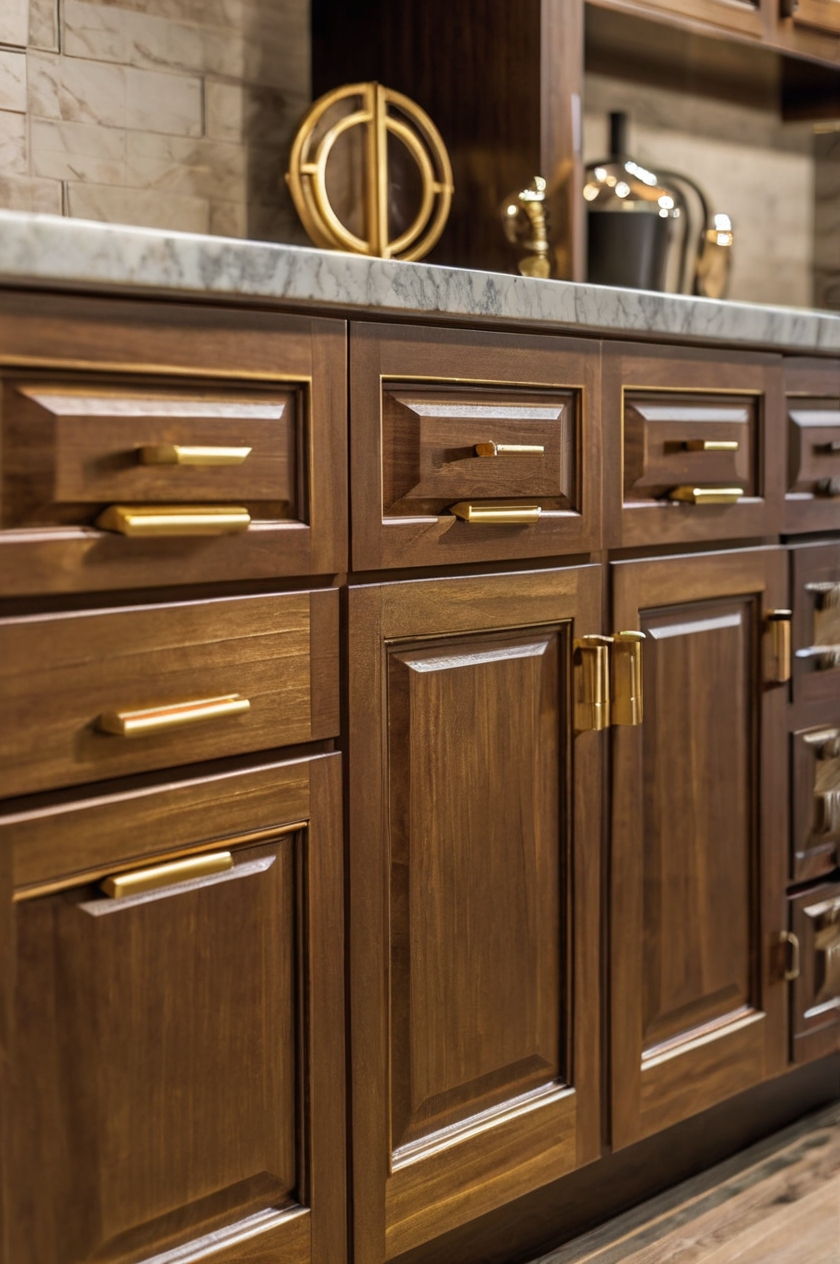Brown cabinets often get a bad rap for being dated or boring, but paired with the right hardware, they become a stunning backdrop for personal style.
The warm tones of wood create a perfect canvas for experimenting with different knob finishes and colors.
I’ve spent countless hours researching, testing, and observing the most impactful hardware combinations specifically for brown cabinetry.
What I’ve discovered is that the right knobs don’t just complement your cabinets—they elevate your entire kitchen.
Let me walk you through amazing knob color combinations that will breathe new life into your brown cabinets without requiring a second mortgage.
✨Click to Get My 101 FREE Designer Room Ideas
Matte Black Knobs: The Timeless Contrast Master



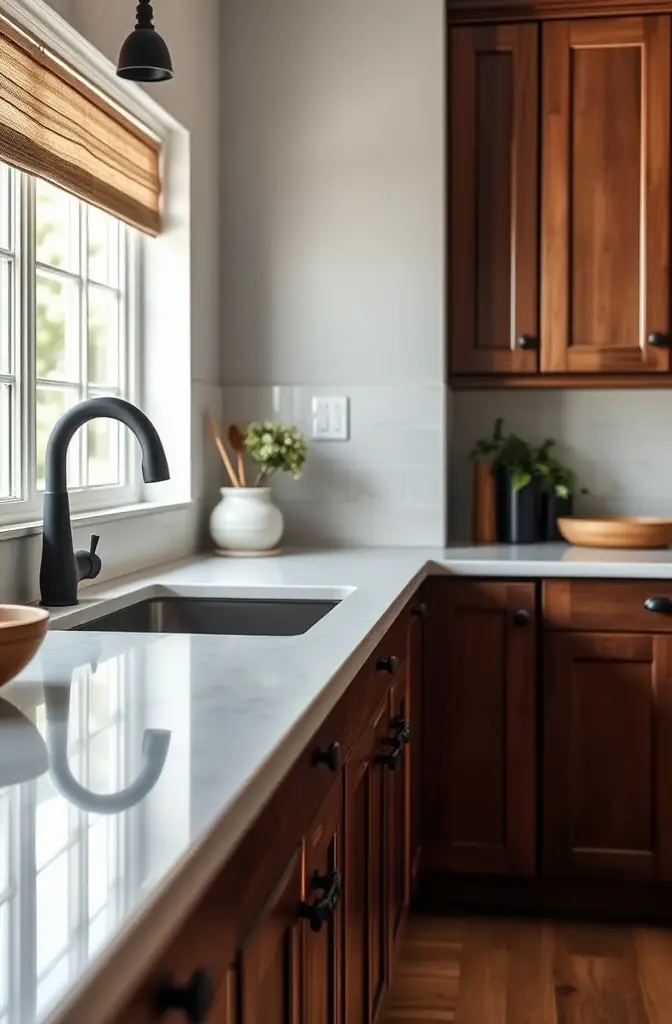
Nothing makes brown cabinets pop quite like the dramatic contrast of matte black knobs.
This combination creates an instant modern farmhouse vibe that works with virtually any kitchen style.
The flat, non-reflective finish of matte black provides a sophisticated anchor point that draws the eye without overwhelming your space.
What makes this pairing particularly effective is how it works with both light and dark brown cabinets.
With lighter oak or maple cabinets, black knobs create a striking, contemporary statement.
On darker walnut or espresso cabinets, they blend seamlessly while adding definition.
The versatility extends to your countertops too – whether you have marble, granite, quartz, or laminate, black knobs provide a unifying element.
For maximum impact, pair your matte black knobs with matching black pulls on larger drawers.
This creates a cohesive look that designers swear by.
Many homeowners report that this simple switch makes their kitchen feel instantly more expensive and put-together.
Black hardware also hides fingerprints and kitchen grime better than most finishes, making it practical for busy families.
If you’re concerned about too much black feeling heavy, mix in some matte black pendants or faucets to distribute the color throughout the space.
The best part?
This look won’t go out of style anytime soon.
Unlike trendy finishes that date quickly, black hardware has stood the test of time and continues to appear in designer kitchens year after year.
For an extra designer touch, choose black knobs with subtle texture or a slightly raised profile to add dimension.
Most home improvement stores carry affordable matte black options, making this an accessible upgrade for any budget.
Brushed Gold Knobs: Luxe Appeal Without the Luxury Price Tag


Nothing elevates brown cabinets quite like the warm gleam of brushed gold knobs.
This combination creates an instant upscale look that transforms your kitchen from ordinary to magazine-worthy.
The subtle brushed finish provides just enough shine without the outdated look of polished brass from decades past.
What makes gold hardware particularly magical with brown cabinets is the complementary color relationship.
The warm undertones in your cabinets are enhanced and highlighted by similar warm tones in the gold.
This creates a harmonious look that feels intentionally designed rather than randomly assembled.
Designers consistently reach for brushed gold when they want to add a touch of luxury to natural wood elements.
The contrast is noticeable enough to add interest but subtle enough to feel sophisticated.
Even the most basic brown cabinets suddenly look custom when adorned with tasteful gold knobs.
For medium to dark brown cabinets, gold hardware creates a rich, intimate feel perfect for creating cozy kitchen spaces.
If your brown cabinets lean toward the lighter end of the spectrum, gold knobs add weight and substance to the overall aesthetic.
This combination works particularly well if you have other warm elements in your kitchen, like copper pots or woven textiles.
The cohesive color story makes your kitchen feel thoughtfully curated.
Lighting plays a crucial role in showcasing this pairing – under-cabinet lighting will make your gold knobs gleam beautifully against the brown backdrop.
Many homeowners report receiving compliments specifically on this combination, as it stands out without feeling trendy or overly bold.
For an extra designer touch, consider matching your faucet and light fixtures to your gold hardware for a pulled-together look.
Unlike some trendier options, brushed gold has proven its staying power in kitchen design over the past decade.
The investment is minimal compared to cabinet replacement, but the visual impact is substantial.
Brushed Nickel Knobs: The Versatile Chameleon That Works With Everything

Brushed nickel knobs are the quiet heroes of kitchen design when paired with brown cabinets.
This combination creates a timeless, understated elegance that complements virtually any kitchen style.
The soft, muted silver tone of brushed nickel provides just enough contrast against brown without creating harsh visual breaks.
What makes this pairing particularly effective is how it bridges traditional and contemporary design sensibilities.
If your kitchen has transitional elements, brushed nickel knobs help unify these different style threads.
The slightly textured finish catches light in subtle ways, adding dimension to your cabinets without being flashy or demanding attention.
Many kitchen designers recommend brushed nickel as a foolproof choice when you’re uncertain about which direction to take your hardware.
This finish has remarkable staying power in the design world, meaning your investment will look current for years to come.
For lighter brown cabinets with honey or golden undertones, nickel provides a cool counterpoint that balances the warmth.
On darker espresso or chocolate-toned cabinets, brushed nickel creates definition without the stark contrast that black or white might create.
The neutrality of nickel also means it pairs beautifully with virtually any countertop material or backsplash choice.
This adaptability makes it particularly valuable if you’re planning to update other elements of your kitchen in phases.
Another advantage is compatibility with appliances – most kitchens feature stainless steel appliances, and brushed nickel coordinates perfectly without matching exactly.
This subtle coordination creates a cohesive feeling throughout the space.
Homeowners with children particularly appreciate how forgiving brushed nickel is – it shows fewer fingerprints than polished finishes and maintains its appearance well over time.
For maximum impact, choose knobs with simple, clean lines that let the finish be the star.
The understated sophistication of this combination works equally well in farmhouse, modern, and traditional kitchen settings.
If you’re selling your home, real estate agents often recommend this pairing as it appeals to the widest range of potential buyers.
Copper Knobs: Warm Metallic Magic for Rustic Appeal

Copper knobs against brown cabinetry create a stunning warmth that few other combinations can match.
This pairing exudes rustic sophistication with a hint of old-world charm that transforms ordinary cabinets into statement pieces.
The rich, reddish-orange undertones of copper create a beautiful harmony with the natural wood tones in brown cabinets.
What makes this combination particularly special is how the copper develops a natural patina over time.
Your kitchen hardware actually becomes more beautiful with use, developing unique character marks that tell the story of your family gatherings and meal preparations.
This living finish creates a sense of history and authenticity that mass-produced kitchens often lack.
For medium-toned brown cabinets, copper knobs create a subtle tonal variation that adds depth and interest.
On darker cabinets, copper provides a pop of brightness that prevents the overall look from feeling heavy or monotonous.
Many designers are embracing copper for its ability to blend contemporary and traditional elements seamlessly.
This versatility makes it ideal for homes that incorporate multiple design styles or for homeowners who like to refresh their decor periodically.
The warm glow of copper knobs creates an inviting atmosphere that makes your kitchen feel like the heart of the home.
This welcoming quality is particularly effective in open-concept spaces where the kitchen needs to feel connected to living areas.
For a cohesive look, consider adding a few copper accents elsewhere in the kitchen – perhaps a copper fruit bowl or pendant lights.
These thoughtful touches distribute the metallic element throughout the space for a designed-not-decorated feel.
Lighting plays a significant role in showcasing copper hardware – under-cabinet lights will make these knobs glow beautifully against brown cabinets.
Many homeowners report that this combination receives the most compliments from guests, who often ask for details about where to find similar hardware.
Unlike some trending finishes that quickly look dated, copper has been used in kitchens for centuries, giving it remarkable staying power.
For an extra designer touch, consider mixing copper knobs with copper bin pulls on drawers for textural variety.
✨Click to Get My 101 FREE Designer Room Ideas
Bronze Knobs: Timeless Elegance With Old-World Charm



Oil-rubbed bronze knobs paired with brown cabinets create a timeless, sophisticated look that whispers rather than shouts.
This combination brings a sense of history and permanence to your kitchen that few other pairings can achieve.
The deep, rich tones of bronze hardware complement the natural warmth of wood cabinets in a way that feels organic and intentional.
What makes bronze particularly special is its dimensional quality – the darkened background with hints of copper undertones creates visual depth.
These subtle color variations mean each knob catches the light slightly differently, adding character to your cabinetry.
Designers often reach for bronze when creating kitchens that feel collected over time rather than installed all at once.
The slightly antiqued appearance of bronze hardware gives even new cabinets a sense of heritage and craftsmanship.
For lighter brown cabinets, bronze knobs provide anchoring points that add weight and substance to the overall design.
On medium to dark brown cabinetry, bronze creates a sophisticated tone-on-tone effect that exudes quiet luxury.
Many homeowners appreciate how this combination bridges different design styles – it works equally well in traditional, Mediterranean, farmhouse, and even modern rustic kitchens.
This versatility makes bronze a safe bet if you enjoy changing your decor without replacing hardware.
Another advantage is how forgiving bronze finishes are – they hide water spots and fingerprints better than most other options.
This practical benefit makes them ideal for busy kitchens where function is as important as form.
The subtle contrast between brown cabinets and bronze hardware creates definition without the stark division that brighter metals might impose.
This harmonious relationship allows other elements in your kitchen to take center stage when desired.
For maximum impact, consider extending the bronze finish to your faucet, light fixtures, and even switch plates for a cohesive design statement.
Many interior designers note that bronze hardware is one of the few trends that has maintained its popularity for decades without looking dated.
This staying power makes it a wise investment for homeowners who want their kitchen to look current for years to come.
Crystal and Glass Knobs: Unexpected Sparkle for Traditional Brown Cabinets


Crystal and glass knobs bring an unexpected element of sparkle and refinement to brown cabinets.
This surprising combination creates a captivating balance between rustic warmth and elegant sophistication.
The transparency and reflective qualities of glass knobs catch and play with light in ways that metal simply cannot match.
What makes this pairing particularly magical is the contrast between the substantial solidity of wood cabinets and the delicate brilliance of crystal.
This juxtaposition creates visual interest that draws the eye and elevates everyday cabinets to statement pieces.
Many designers are embracing this combination for its ability to bridge traditional and contemporary styles seamlessly.
The classic look of crystal knobs references historical design, while their sparkle adds a fresh, modern element to brown cabinetry.
For darker brown cabinets, clear crystal knobs provide bright punctuation marks that prevent the overall look from feeling heavy.
On lighter brown finishes, the prismatic effect of crystal creates depth and dimension through light refraction.
Homeowners particularly love how this combination changes throughout the day as natural light shifts and casts different patterns through the glass.
This dynamic quality means your kitchen never looks quite the same twice – it’s constantly revealing new aspects of beauty.
Unlike some trendy hardware options, crystal and glass knobs have remained in style for centuries, giving them remarkable staying power.
This timelessness makes them a safe investment for homeowners concerned about resale value or future design changes.
For a cohesive look, consider incorporating other glass elements in your kitchen – perhaps glass pendant lights or a glass-front cabinet section.
These thoughtful touches distribute the reflective element throughout the space for a designed-not-decorated feel.
Many interior designers note that this combination works particularly well in kitchens that transition between formal and casual spaces.
The inherent elegance of crystal elevates the simplicity of brown cabinets to match more formal adjacent rooms.
For an extra special touch, consider vintage or antique crystal knobs that bring character and history to newer cabinetry.
Ceramic White Knobs: Crisp Contrast for Country-Chic Vibes
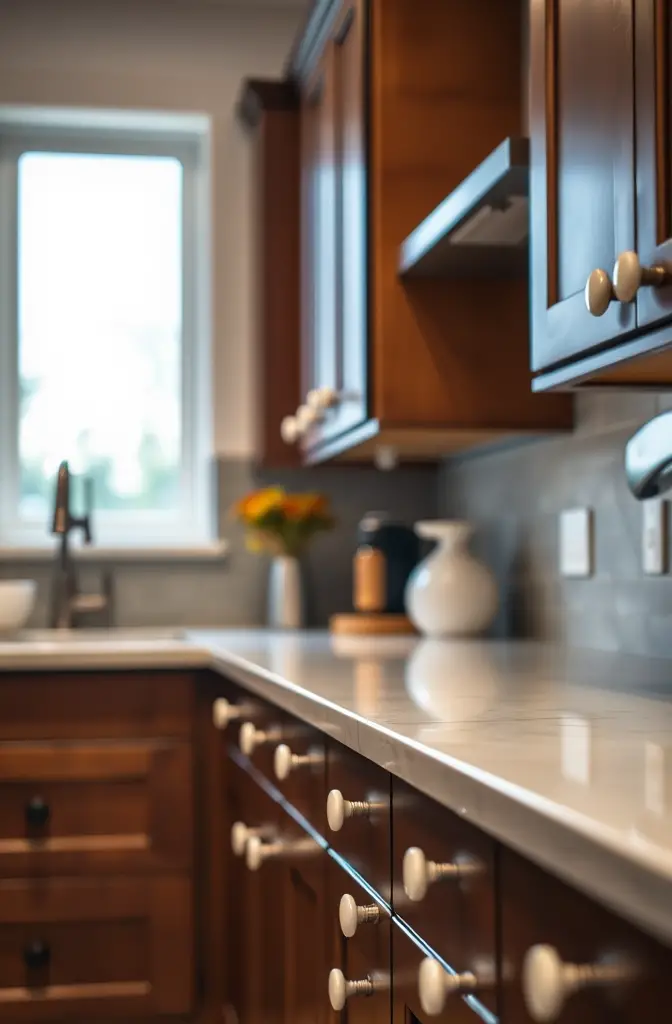
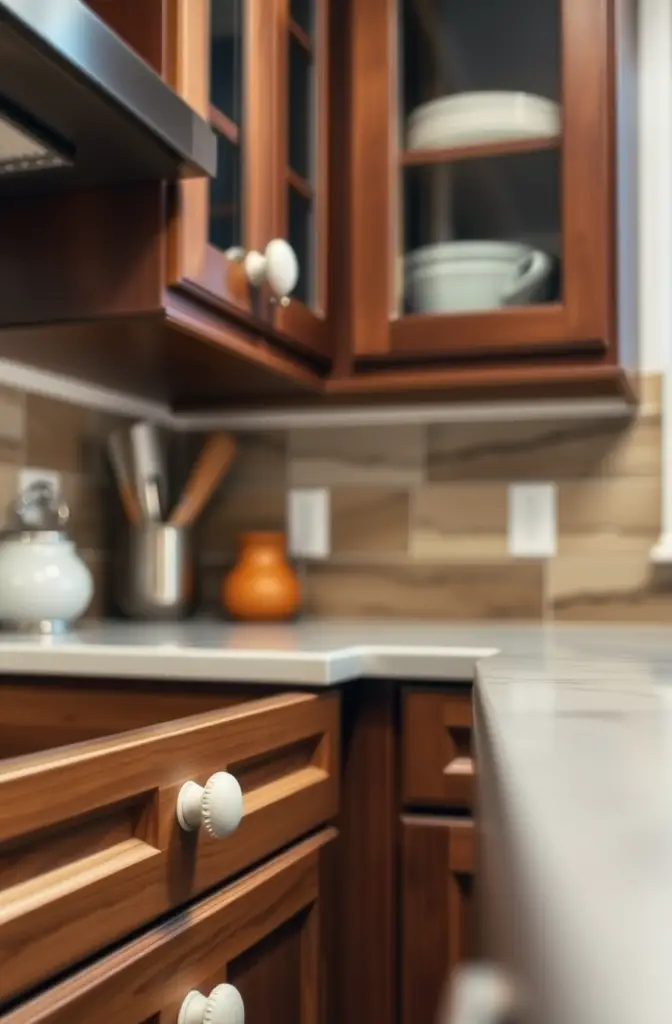
Ceramic white knobs create a striking, clean contrast against the richness of brown cabinets.
This combination brings an immediate brightness that makes your kitchen feel fresh and updated without major renovations.
The smooth, non-metallic finish of ceramic provides a textural counterpoint to the natural grain patterns in wood cabinetry.
What makes white ceramic knobs particularly effective is their ability to bridge different design aesthetics.
They work beautifully in farmhouse kitchens, cottage-inspired spaces, Scandinavian designs, and even modern minimalist settings.
This versatility makes them a safe choice if you enjoy refreshing your decor periodically without changing hardware.
For darker brown cabinets, white ceramic knobs create eye-catching punctuation that prevents the cabinetry from feeling heavy or overwhelming.
On medium-toned brown cabinets, they provide definition that helps showcase the natural beauty of the wood grain.
Many designers appreciate how this combination references historical kitchens while still feeling current and fresh.
This timeless quality ensures your kitchen won’t quickly look dated as trends come and go.
Homeowners with children particularly value the durability of ceramic knobs – they don’t show fingerprints like metal finishes and are easy to wipe clean.
These practical benefits make them ideal for busy family kitchens where function is as important as form.
The crisp look of white ceramic against brown creates a sense of intentional design that elevates even basic cabinet styles.
This high-contrast pairing makes budget-friendly cabinets look more custom and thoughtfully chosen.
For maximum impact, consider adding other white elements throughout the kitchen – perhaps white dishes displayed on open shelving or a white farmhouse sink.
These coordinating touches distribute the color throughout the space for a cohesive feel.
Many interior designers note that this combination particularly shines in kitchens with natural light, as the white ceramic reflects and maximizes brightness.
This light-enhancing quality makes white ceramic knobs an excellent choice for kitchens that tend to feel dark or cave-like.
For an extra designer touch, look for ceramic knobs with subtle details like beaded edges or gentle texturing.
Patina Green Knobs: Vintage-Inspired Accent for Earthy Kitchens
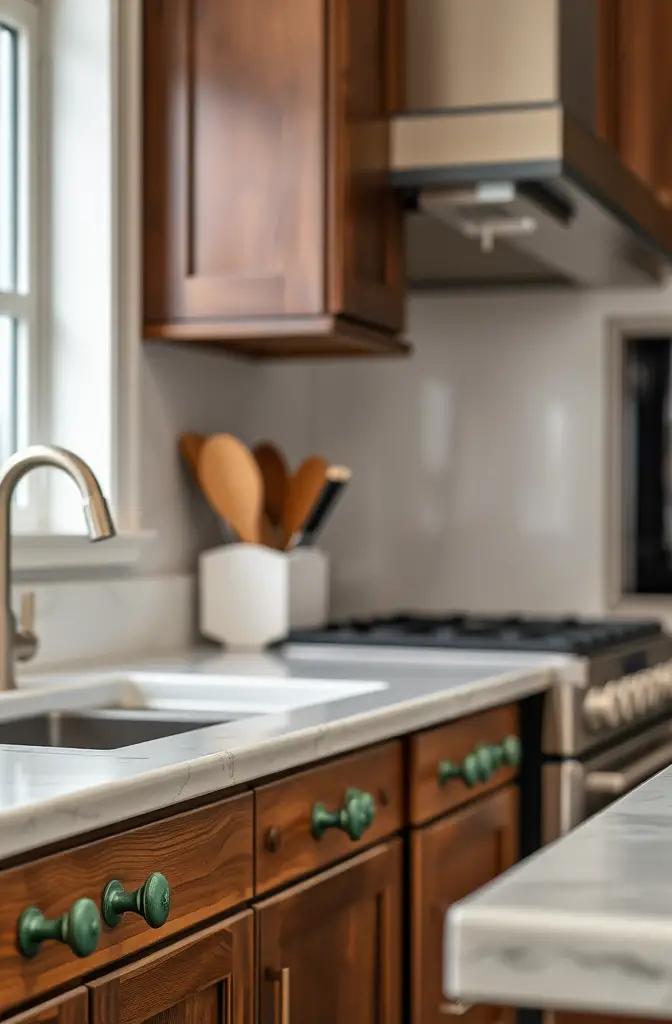
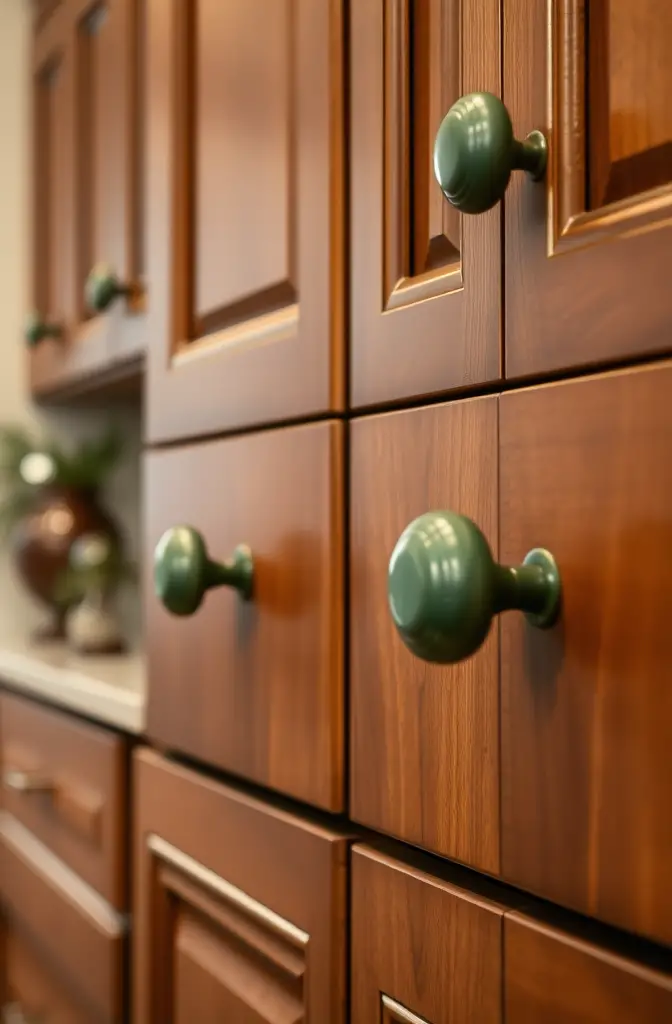
Patina green knobs create an unexpected color story against brown cabinets that feels both fresh and timelessly vintage.
This combination evokes the weathered copper roofs of European buildings and brings a sense of history and character to your kitchen.
The soft, aged green tone creates a beautiful complement to the warm undertones typically found in brown cabinetry.
What makes this pairing particularly special is how it references nature – the green-against-brown echoes the relationship between leaves and tree trunks.
This natural harmony creates a grounded, organic feel that many contemporary kitchens lack.
Designers are increasingly reaching for this combination when creating spaces that feel collected and evolved rather than newly installed.
The inherent vintage quality of patina green gives even new cabinets a sense of history and permanence.
For medium to darker brown cabinets, patina green knobs add a touch of brightness without the starkness that white or polished metals might bring.
On lighter brown cabinets, they create a sophisticated, subtle contrast that feels purposeful and designed.
Many homeowners appreciate how this combination works beautifully with various countertop materials, particularly marble and soapstone.
The natural veining in stone counters often contains hints of green that echo and enhance the cabinet hardware.
Unlike some trending hardware choices that quickly look dated, patina green has historical precedent dating back centuries, giving it remarkable staying power.
This historical connection makes it a safe choice for period homes or for those seeking timeless design elements.
The slightly muted quality of patina green creates a soothing visual effect that works well in kitchens designed as peaceful retreats from busy lives.
This calming property makes green hardware particularly well-suited for open-concept homes where the kitchen is visible from living spaces.
For a cohesive look, consider incorporating other aged metal elements – perhaps a copper sink or vintage-inspired pendants with verdigris details.
These thoughtful touches distribute the patina element throughout the space for a curated, collected feel.
Many designers note that this combination creates immediate character in newer homes that might otherwise feel lacking in architectural interest.
This instant personality makes it particularly valuable for cookie-cutter builder spaces seeking distinction.
✨Click to Get My 101 FREE Designer Room Ideas
Two-Tone Knobs: The Designer Secret for Contemporary Edge



Two-tone knobs represent the cutting edge of kitchen hardware trends when paired with brown cabinets.
This combination creates visual interest through layered colors that add depth and dimension to ordinary cabinetry.
The dual-finish approach – perhaps black with gold accents or nickel with bronze details – offers sophistication that single-color knobs simply can’t match.
What makes this pairing particularly effective is how it bridges different elements within your kitchen.
If your space features mixed metals or multiple wood tones, two-tone knobs can unify these various components.
Designers frequently turn to this option when creating eclectic spaces that feel curated rather than matchy-matchy.
The contemporary edge of two-tone hardware modernizes traditional brown cabinets without erasing their classic appeal.
For darker brown cabinets, knobs featuring light and dark elements create dynamic contrast that prevents the overall look from feeling heavy.
On lighter brown cabinetry, two-tone hardware adds visual weight and substance that anchors the design.
Many homeowners appreciate how this combination allows them to incorporate on-trend metallic finishes in a subtle, sophisticated way.
This approachability makes it perfect for those who might be hesitant to commit fully to a bold metal choice.
Unlike single-finish options, two-tone knobs create a layered look that suggests a designer’s thoughtful touch.
This elevated aesthetic makes even budget-friendly cabinets look more expensive and intentionally chosen.
The versatility of two-tone hardware makes it particularly valuable during kitchen transitions or phased renovations.
As you update appliances or fixtures over time, having multidimensional hardware helps tie together both old and new elements.
For maximum impact, choose knobs where the two colors create meaningful contrast rather than subtle variation.
This distinct differentiation creates the contemporary edge that makes this combination so effective.
Many interior designers note that this option works particularly well in kitchens that blend different design styles.
The inherent flexibility of two-tone hardware helps bridge traditional brown cabinets with more modern design elements elsewhere in the space.
For an extra sophisticated touch, consider knobs where one color appears as an inlay or rim detail rather than a simple split design.
Leather-Wrapped Knobs: Unexpected Texture for Rustic-Modern Appeal

Leather-wrapped knobs create an unexpected textural element that transforms brown cabinets from ordinary to extraordinary.
This combination brings warmth and tactile interest that metal hardware simply cannot provide.
The natural, organic quality of leather creates a beautiful dialogue with the natural wood tones of brown cabinetry.
What makes this pairing particularly special is the sensory experience it provides – the soft feel of leather creates an interactive element every time you open a cabinet.
This tactile quality adds a layer of luxury that transcends purely visual design considerations.
Designers are increasingly turning to this option when creating spaces that balance masculine and feminine energy.
The combination of structured wood cabinetry with supple leather details creates perfect equilibrium between hard and soft elements.
For darker brown cabinets, lighter tan or cognac leather knobs create beautiful contrast that highlights both materials.
On lighter brown cabinetry, deeper burgundy or chocolate leather creates sophisticated definition that feels intentional and designed.
Many homeowners appreciate how leather knobs develop a rich patina over time, much like fine leather furniture.
This evolving character means your kitchen actually becomes more beautiful through use – a rare quality in today’s disposable design culture.
Unlike trendy hardware options that quickly look dated, leather has been used in interior details for centuries, giving it remarkable staying power.
This historical precedent makes it a safe choice for those concerned about long-term design relevance.
The subtle color variations within leather create nuanced relationships with the grain patterns in your brown cabinets.
This delicate interplay reveals new details under different lighting conditions throughout the day.
For a cohesive look, consider incorporating other leather elements in your kitchen – perhaps leather counter stools or a small leather detail on open shelving.
These thoughtful touches distribute the textural element throughout the space for a curated, collected feel.
Many interior designers note that this combination creates immediate warmth that helps kitchens feel inviting rather than clinical.
This welcoming quality makes leather knobs particularly valuable in modern kitchens that might otherwise feel cold or sterile.
For an extra special touch, consider hand-stitched leather knobs that showcase artisanal craftsmanship.
Wood Knobs: Tonal Sophistication for Natural Harmony
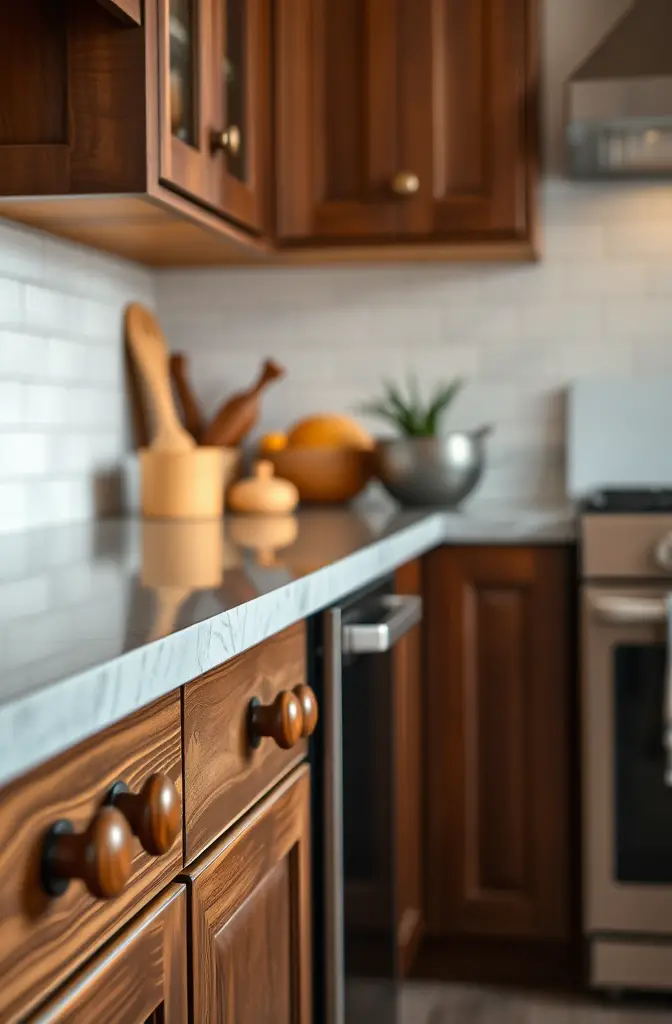
Wood knobs on brown cabinets create a sophisticated tonal story that feels organic and intentionally designed.
This combination showcases a designer’s understanding of subtle variation and textural interplay.
The natural material connection between cabinets and knobs creates a harmonious relationship that feels both deliberate and effortless.
What makes this pairing particularly special is the opportunity to introduce contrast through wood species rather than material type.
A light maple knob on dark walnut cabinets creates striking definition without the harshness of metal against wood.
Conversely, deep mahogany knobs on lighter oak cabinets add weight and gravitas to the overall design.
Designers often reach for this combination when creating spaces that privilege natural materials and organic design principles.
The consistency of wood throughout creates a serene, cohesive aesthetic that many find deeply calming.
For homeowners concerned about environmental impact, all-wood kitchens represent a commitment to renewable materials.
This sustainability story adds meaning beyond mere aesthetics.
Many appreciate how wood knobs feel warm to the touch, unlike cool metal options that can feel jarring first thing in the morning.
This tactile comfort creates a subtle but meaningful improvement in your daily kitchen experience.
Unlike some trending hardware choices, wood-on-wood combinations have historical precedent dating back centuries, giving them remarkable staying power.
This timelessness makes them a safe choice for those seeking enduring design versus fleeting trends.
The natural variation within wood grain means that each knob is slightly different, creating a handcrafted quality even in production cabinetry.
This unique character adds depth and interest that uniform materials cannot provide.
For maximum impact, consider knobs made from exotic or unusual wood species that create distinct contrast against your cabinet material.
Zebra wood, purpleheart, or bocote all offer dramatic grain patterns that serve as miniature art pieces on each door.
Many interior designers note that this combination works particularly well in minimalist kitchens where the subtle material variations become the focal point.
This restrained approach allows the natural beauty of wood to take center stage without competition from other elements.
For an extra special touch, consider knobs with visible end grain that showcase the concentric growth rings of the tree.
Burnished Brass Knobs: Old-World Luxe for Traditional Appeal
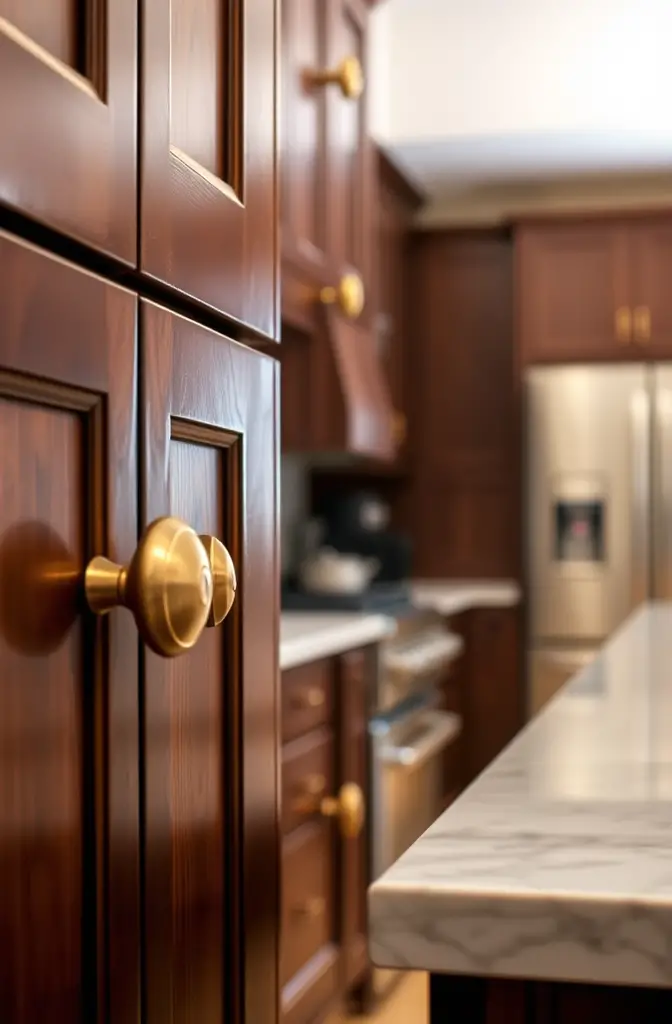
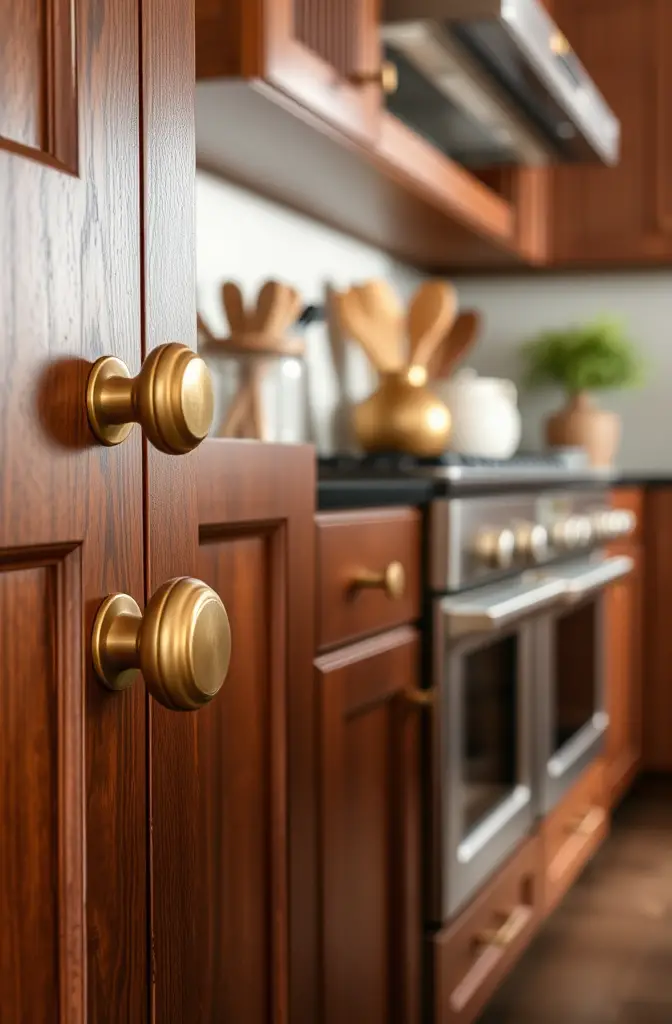
Burnished brass knobs create a rich, aged patina against brown cabinets that exudes old-world elegance.
This combination brings immediate warmth and character that makes your kitchen feel established and timeless.
The antiqued finish creates depth and dimension that polished metals simply cannot match.
What makes burnished brass particularly effective is how it mimics the natural aging process of brass over decades.
This instant history gives even new cabinets a sense of permanence and heritage.
For lighter brown cabinets, burnished brass adds weight and substance that grounds the overall design.
On darker brown cabinetry, it creates a sophisticated tone-on-tone effect that whispers luxury rather than shouting it.
Many designers appreciate how this combination references historical design while still feeling relevant to contemporary aesthetics.
This timelessness ensures your kitchen won’t quickly look dated as trends cycle through.
Homeowners particularly value how forgiving burnished brass is – the already-antiqued finish means fingerprints and water spots blend into the patina rather than standing out.
This practical benefit makes it ideal for busy family kitchens where perfect maintenance isn’t realistic.
Unlike some trendy hardware options, burnished brass has cycled in and out of fashion for centuries, giving it enduring design credibility.
This established history makes it a safe choice for traditional homes or those seeking classic design elements.
The variations within burnished brass finishes create beautiful interplay with the natural grain patterns in wood cabinetry.
This complementary relationship highlights the best qualities of both materials.
For a cohesive look, consider incorporating other brass elements throughout your kitchen – perhaps a brass faucet or vintage-inspired pendant lights.
These thoughtful touches distribute the metallic element throughout the space for a designed-not-decorated feel.
Many interior designers note that burnished brass hardware is experiencing a strong resurgence after decades of polished nickel dominance.
This renewed popularity makes it both current and classic – a rare combination in kitchen design.
For an extra special touch, look for burnished brass knobs with architectural details that reference historical periods.
✨Click to Get My 101 FREE Designer Room Ideas
Silver Chrome Knobs: Sleek Modernity for Contemporary Contrast
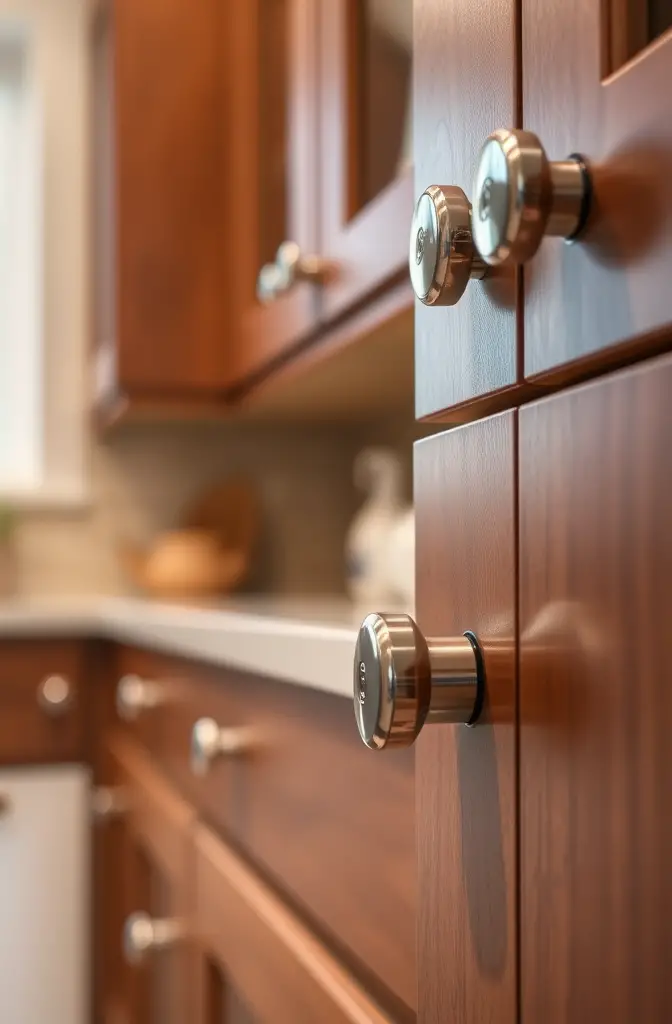
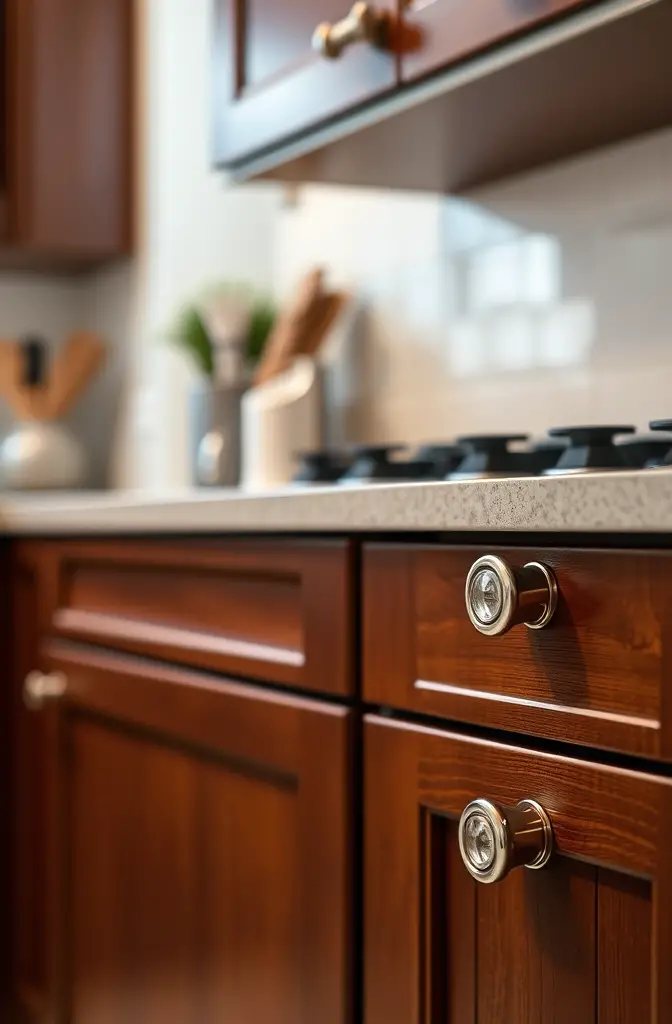
Silver chrome knobs create a striking contemporary edge when paired with traditional brown cabinets.
This combination brings an immediate brightness and reflectivity that makes your kitchen feel clean and current.
The high-shine finish provides maximum contrast against the matte, textural surface of wood cabinetry.
What makes chrome particularly effective is its ability to reflect its surroundings, creating a dynamic visual element that changes as you move through the space.
This interactive quality adds depth and dimension beyond static hardware options.
Designers often turn to this combination when creating transitional spaces that bridge traditional cabinet styles with more contemporary design elements.
The juxtaposition of classic brown wood with sleek chrome creates tension that feels intentional and sophisticated.
For darker brown cabinets, chrome creates punctuation points that prevent the overall look from feeling heavy or monotonous.
On lighter brown cabinetry, chrome adds definition and crispness that heightens the contrast between elements.
Many homeowners appreciate how chrome coordinates beautifully with stainless steel appliances without matching exactly.
This coordination creates cohesion throughout the kitchen without feeling overly matched.
Unlike some hardware finishes that develop patina over time, chrome maintains its bright appearance for years, making it low-maintenance for those who prefer consistent aesthetics.
This durability makes it particularly suitable for rental properties or homes that will eventually be sold.
The clean lines and reflective quality of chrome bring light into spaces that might otherwise feel dark or cave-like.
This brightness-enhancing property makes it valuable for kitchens with limited natural light.
For maximum impact, choose simple, streamlined chrome knobs that let the finish be the star without competing decorative elements.
This minimalist approach creates the strongest contemporary contrast against traditional brown cabinetry.
Many interior designers note that this combination works particularly well in kitchens that open to living spaces with modern furniture.
The chrome hardware creates a visual bridge between the traditional kitchen elements and more contemporary adjacent rooms.
For an extra designer touch, consider pairing chrome knobs with sleek chrome pulls on larger drawers for a cohesive hardware story.

